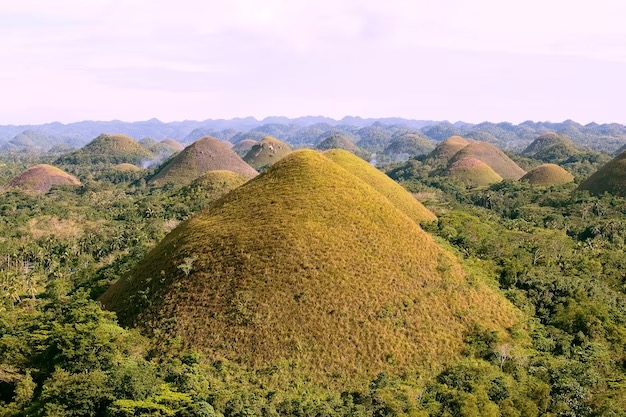Chocolate Hills in Bohol: A Natural Wonder of the Nation

SHARE
Nestled in the heart of Bohol, Philippines, lies one of nature’s most peculiar creations—the Chocolate Hills. These enigmatic geological formations have captivated travelers for centuries, earning their place as one of the most iconic landmarks in the country. With their unique appearance and fascinating origin, it’s no wonder that the Chocolate Hills have been designated as a UNESCO World Heritage Site, solidifying their status as a global treasure.
Formation and Appearance
The Chocolate Hills and its surrounding areas feature a relatively flat to rolling terrain, with elevations ranging from 100 meters to 500 meters above sea level. Recognized for its scientific significance and unique geomorphology, it was designated as the country’s third National Geological Monument on June 18, 1988.
Resembling the formations found in Java, the Chocolate Hills consist of conical and nearly symmetrical hills of uniform size, extending aesthetically across the landscape. These hills are believed to have formed from the uplift of coral deposits and subsequent erosion caused by rainwater. Scattered across the towns of Carmen, Batuan, and Sagbayan, there are approximately 1,776 hills sharing the same distinctive shape. During the dry season, when rainfall is scarce, the grass covering these hills takes on a chocolate brown hue, hence the name “Chocolate Hills,” reminiscent of a well-known confectionery.
Geological Mystery
The origins of the Chocolate Hills have puzzled scientists and geologists for generations. While there are several theories, the prevailing explanation suggests that they are the result of uplifted coral deposits and the subsequent erosion by water and wind over millions of years. This process sculpted the once underwater limestone into the unique formations we see today. Despite their uniformity, each hill maintains its distinct character, contributing to the mystique that surrounds them.
Cultural Significance
For the indigenous people of Bohol, the Chocolate Hills hold deep cultural significance. Legends and folklore abound, with one popular tale attributing their formation to the tears of a grief-stricken giant who wept over the loss of his beloved. Others believe that the hills are the remnants of a mythical giant’s leftover food or the result of a battle between two giants hurling rocks at each other.
Presidential Proclamation and UNESCO Recognition
The Chocolate Hills were declared a protected area and designated as a “National Geological Monument and a Protected Landscape” by virtue of Proclamation No. 1037 on July 1, 1997, under the administration of former President Fidel V. Ramos.
It was declared the country’s 3rd National Geological Monument on June 18, 1988.
UNESCO recognized the Chocolate Hills for their outstanding universal value, citing their exceptional beauty, geological significance, and cultural importance to the people of Bohol and the Philippines as a whole. UNESCO also declared it the first global geo-park in the Philippines in 2023.
Preserving a Natural Treasure
As tourism to the region continues to grow, there is a renewed focus on preserving the ecological balance of the Chocolate Hills. Sustainable development initiatives aim to minimize the impact of human activities while promoting responsible tourism practices. Conservation efforts also extend to the protection of the flora and fauna that call the hills home, safeguarding the biodiversity of this unique landscape.
The Chocolate Hills stand as a testament to the awe-inspiring power of nature and the enduring connection between humans and the environment. As we strive to protect and preserve these wonders in connection to the latest issue of establishing commercial establishments around the vicinity, let us also remember to cherish and respect the delicate balance of the world we share.
*Cover Photo/Thumbnail Photo: Freepik
RELATED ARTICLES

I’m a Christian and I Got No Startup Money!

Tempted to Abandon My Calling

A Christian’s Call to Wise Listening









